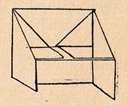| The Public Paperfolding History Project
Last updated 11/2/2025 x |
|||||||
| Papiro-Zoo: Manual Practico de Cocotologia o Papirologia by Giordano Lareo, 1941 | |||||||
| 'Papiro-Zoo:
Manual practico de cocotologia o papirologia' by Giordano
Lareo was first published by Larco in Buenos Aires in
1941. Revised and expanded second and third editions were
published by Libraria 'El Ateneo' Editorial in 1944 and
1951. You can find some details of the 1944 second edition here. You can find full details of the 1951 third edition here. I have not seen a full copy of the 1941 first edition or the 1944 second edition. The information about the designs in the Analysis (see below) are taken from the 1951 third edition but I believe they are most probably identical to those that originally appeared in this first edition. According to the Contents page (see below), pages 93 to 109 are devoted to 'Figuras varias'. These pages held untitled drawiings of nine additional designs which were not otherwise explained in the work. The original Prologo by Eduardo Blanco-Amor (see below) is mostly notable for its statement that:'The fundamental thing about papyrology ... consists in not cutting and pasting. ... Anything other than this is vile fraud. Beware students of papyrology! Do not cut and do not paste!', a 'morality' which, presumably, he had acquired from the author.
********** This work is mentioned in Gershon Legman's 'Bibliography of Paperfolding' which was published in 1952.
**********
********** I have reproduced this Prologo from the 1951 edition but believe it was identical in all three editions.
********** Analysis First Part El Vaso - The Paper Cup
********** El Sofa - The Sofa
The text states that a variation with a firmer seat can be made by 'unfolding it and inserting the tips into the angles formed at the top' but there are no diagrams to show how this variation works.
********** La Silla - The Chair
********** La Pajarita - The Cocotte / Pajarita
This version of the design is made from a doubly blintzed square. The text also mentions that many variations are possible, including a version with a colour-change head, but does not say how this is to be achieved.
********** El Barquito - The Paper Boat
********** El Bonete - The Curate's Hat
********** Second Part La Paloma - The Flapping Bird The flapping action is explained in the text.
********** El Condor Developed from a bird base
********** El Pinguino Developed from a bird base
********** El Elefante Developed from a bird base. This design only has one back leg.
********** La Jirafa - The Spanish Elephant Developed from a bird base. This design only has one back leg and one horn.
********** El Loro Developed from a bird base. This design has two feet.
********** La Rana An inflatable design developed from a bird base.
********** El Pavo Real This appears to be Solorzano's Peacock.
********** Figuras Varias As far as I can discover these figures were: Pavo (turkey) ********** Toro (bull) ********** Conejo (rabbit) ********** Ciervo (deer)
********** Oveja (or Perro?) (sheep or dog) ********** Rinoceronte (rhinoceros) The folding method for this design was subsequently explained in the 1944 second edition. ********** Raton (rat) The folding method for this design was subsequently explained in the 1944 second edition. ********** Nandu (rhea) The folding method for this design was subsequently explained in the 1944 second edition. ********** Jinete a caballo (horse with rider)
********** |
|||||||





























